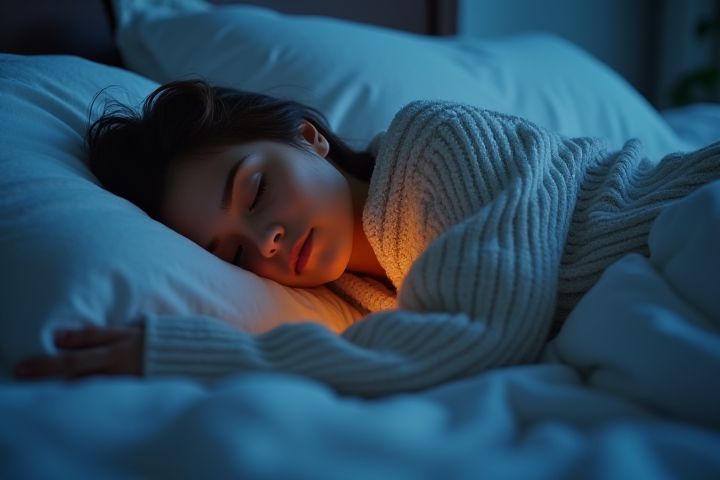
House temperature significantly influences your quality of sleep, as the ideal range for most adults is between 60 to 67 degrees Fahrenheit (15 to 19 degrees Celsius). At cooler temperatures, your body can maintain a lower core temperature, which is essential for falling asleep and staying asleep. A room that is too warm may lead to discomfort, causing frequent awakenings and difficulty in reaching deep sleep stages. Proper ventilation and bedding choices can help regulate your sleeping environment's temperature, enhancing your overall rest. Maintaining a comfortable atmosphere not only improves sleep quality but also supports better health and well-being.
Can House Temperature Affect Sleep
Ideal sleep temperature range
The ideal sleep temperature range for optimal rest is typically between 60 to 67 degrees Fahrenheit (15 to 19 degrees Celsius). Within this zone, your body can maintain a lower core temperature, which facilitates the natural drop in body temperature necessary for sleep onset. If the room is too hot or too cold, it can disrupt your sleep cycle, leading to difficulties in falling asleep and maintaining deep sleep stages. By setting your thermostat within this recommended range, you can enhance sleep quality, improve focus during waking hours, and boost overall health and well-being.
Impact of high temperatures
High temperatures can significantly disrupt your sleep quality, with optimal sleeping conditions typically ranging between 60-67degF (15-19degC). Exposure to temperatures exceeding 75degF (24degC) can lead to increased wakefulness and diminished restorative sleep stages, affecting your overall sleep efficiency. Research indicates that even a 1degF rise in bedroom temperature can amplify discomfort and reduce the duration of deep sleep, essential for cognitive functioning and memory consolidation. Thus, maintaining a cooler sleep environment is crucial for improving your focus and productivity during waking hours.
Effect of low temperatures
Low temperatures, specifically below 60degF (15degC), can significantly disrupt your sleep quality. Studies indicate that a cooler room temperature enhances the body's ability to enter deep sleep, while temperatures below this threshold may lead to disturbances that result in frequent awakenings. Prolonged exposure to low temperatures can also cause discomfort, making it challenging to maintain a restful state throughout the night. For optimal sleep, aim to keep your bedroom between 60degF and 67degF (15degC to 19degC) to promote a better sleeping environment.
Thermoregulation process
House temperature significantly influences sleep quality, primarily through the thermoregulation process. The human body naturally cools down to initiate sleep, reaching its lowest temperature during deep sleep stages, typically between 60degF to 67degF (15degC to 19degC). A comfortable sleep environment promotes optimal thermoregulation, aiding in the transition from wakefulness to sleep, while excessive heat can disrupt this process, leading to restlessness or wakefulness. Ensuring your bedroom maintains a cool temperature can enhance your overall sleep quality and support cognitive function during waking hours.
Sleep stage disruption
House temperature plays a crucial role in sleep quality, significantly influencing sleep stage disruption. Studies indicate that an optimal bedroom temperature, typically between 60 to 67 degrees Fahrenheit (15 to 19 degrees Celsius), promotes deeper sleep cycles, including REM and slow-wave sleep. When the temperature is too high or too low, it can cause frequent awakenings and hinder the transition between different sleep stages, leading to fragmented rest. Ensuring a comfortable sleeping environment is essential for maximizing your sleep efficiency and achieving restorative rest.
Melatonin production
House temperature plays a crucial role in regulating sleep quality, largely due to its impact on melatonin production. Melatonin, a hormone produced by the pineal gland, is essential for signaling the body that it's time to sleep, and its secretion is sensitive to environmental conditions, including temperature. An ideal sleeping environment typically ranges between 60 to 67 degrees Fahrenheit, which supports the natural decline in body temperature that occurs during sleep and optimizes melatonin levels. Maintaining a comfortable room temperature can enhance your overall sleep experience, improve duration, and increase the overall effectiveness of melatonin's restorative effects.
Bedding and sleepwear
House temperature significantly influences the quality of your sleep, with optimal conditions generally falling between 60-67degF (15-19degC). Proper bedding materials, such as breathable cotton or moisture-wicking fabrics, help regulate body temperature and enhance comfort, thus improving sleep quality. Sleepwear crafted from lightweight, temperature-regulating materials can minimize overheating, further supporting a restful night. Ensuring your sleep environment, including bedding and sleepwear, aligns with these temperature guidelines can lead to enhanced focus and better overall well-being during waking hours.
Humidity levels influence
Humidity levels significantly impact your sleep quality by affecting both comfort and respiratory health. High humidity can create a stuffy environment, making it difficult for your body to regulate temperature, while low humidity may lead to dry air, causing irritation to your throat and nasal passages. Optimal relative humidity levels for sleep typically range from 30% to 50%, as this range can promote better airflow and reduce allergens. Maintaining appropriate humidity in your bedroom not only enhances your comfort but also supports deeper, more restorative sleep.
Air quality considerations
House temperature significantly influences sleep quality, with an optimal range typically between 60 to 67 degrees Fahrenheit promoting better rest. Poor air quality, characterized by high levels of pollutants or allergens, can exacerbate sleep disturbances, making it harder to breathe comfortably. Maintaining good ventilation and using air purifiers can enhance indoor air quality, reducing irritants that may disrupt your sleep cycles. Ensuring a cooler, cleaner environment not only aids in falling asleep but also improves overall cognitive focus during waking hours.
Room ventilation benefits
Room temperature significantly influences sleep quality, and proper ventilation enhances this effect. An ideal sleeping temperature ranges from 60degF to 67degF (15degC to 19degC), promoting deeper sleep cycles. Effective ventilation lowers humidity levels, creating a fresher atmosphere that can aid in quicker sleep onset and improved cognitive function during the day. You can enhance ventilation by utilizing windows, fans, or air purifiers, ensuring optimal air circulation and comfort for restful sleep.
